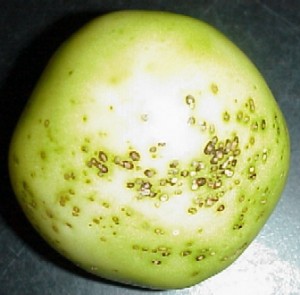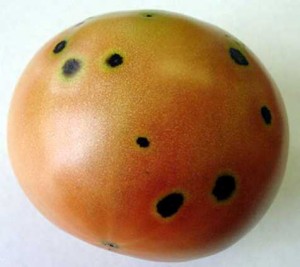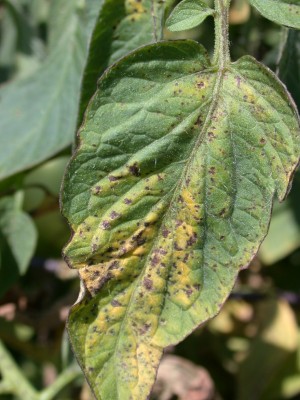Bacterial Speck (Spot) on Tomatoes
 Causal Agent
Causal Agent
The bacterium, Xanthomonas campestris pv. vesicatoria
Hosts
Tomato and pepper
Symptoms
 This disease is most important in the eastern half of Oklahoma where rainfall and
humidity levels are moderate to high. The bacteria survive on diseased plant debris
and on tomato seed. Leaves, stems, and fruit may be infected at any growth stage when
plants are wet and temperatures range from 75-86 degrees F. The bacteria enter plants
through natural openings or wounds and form leaf spots that are dark brown in color.
The leaf spots appear greasy when leaves are wet, and rarely exceed 1/3 of an inch
in diameter. The leaf spots produced in bacterial spot are easily confused with those
produced in bacterial speck and the initial symptoms of the fungal diseases - Septoria
leaf spot and early blight. Bacterial spots are less uniformly distributed over the
leaf surface and lack the tiny fruiting bodies (specks) found within Septoria leaf
spots, and also lack the concentric rings associated with early blight spots. In addition
to the leaf spots produced, a general yellowing of heavily spotted areas on leaves
may occur, followed by leaf scorch. Blighting (rapid death) of foliage progresses
upward on heavily infected plants. Fruit spots are conspicuous on green fruit and
appear raised and scabby, dark brown in color, and are up to 1/3 of an inch in diameter.
Spots on ripe fruit and similar except that they are sunken.
This disease is most important in the eastern half of Oklahoma where rainfall and
humidity levels are moderate to high. The bacteria survive on diseased plant debris
and on tomato seed. Leaves, stems, and fruit may be infected at any growth stage when
plants are wet and temperatures range from 75-86 degrees F. The bacteria enter plants
through natural openings or wounds and form leaf spots that are dark brown in color.
The leaf spots appear greasy when leaves are wet, and rarely exceed 1/3 of an inch
in diameter. The leaf spots produced in bacterial spot are easily confused with those
produced in bacterial speck and the initial symptoms of the fungal diseases - Septoria
leaf spot and early blight. Bacterial spots are less uniformly distributed over the
leaf surface and lack the tiny fruiting bodies (specks) found within Septoria leaf
spots, and also lack the concentric rings associated with early blight spots. In addition
to the leaf spots produced, a general yellowing of heavily spotted areas on leaves
may occur, followed by leaf scorch. Blighting (rapid death) of foliage progresses
upward on heavily infected plants. Fruit spots are conspicuous on green fruit and
appear raised and scabby, dark brown in color, and are up to 1/3 of an inch in diameter.
Spots on ripe fruit and similar except that they are sunken.
Control

